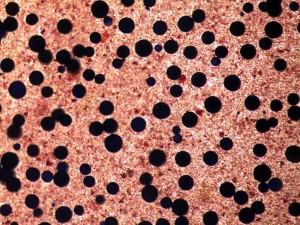Mucosal immunity and early host-pathogen interactions in bivalves
This project translates our interest in the early interactions between bivalves and suspended particles, whether suspended particles represent food particles or pathogens. For instance, several aspects of feeding, mutualistic symbiosis and parasitism are similar, particularly with regard to common principles of particle processing at first encounter with the animal. This project uses a combination of methods and approaches (large scale proteomic and transcriptomic as well as nowaday traditional confocal microscopy methods) to characterize immune effectors (blood cells and bioactive molecules) associated with mucosal interfaces in bivalves and how these interact with waterborne microbes.

Confocal laser scanning microscopy represents an efficient technique to investigate the early steps of the invasion of bivalve hosts by their parasites
With that regard, our research group has been particularly interested in the role of mucus covering bivalve’s pallial organs (body wall, gills, labial palps and mantle) in the recognition of waterborne microorganisms, including food particles (see “Particle selection” project) and pathogenic microorganisms. We demonstrated that pallial mucus contains recognition proteins (lectins and other immune-reactive proteins) that specifically bind waterborne microbes. We also identified and characterized immune cells associated with mucosal surfaces that appear to occupy a physical and functional niche similar to that of dendritic cells in higher vertebrates. We are currently looking into factors affecting the regulation of these immune effectors and how these interact with microbes colonizing mucosal surfaces, whether these microbes are commensal or pathogenic.





